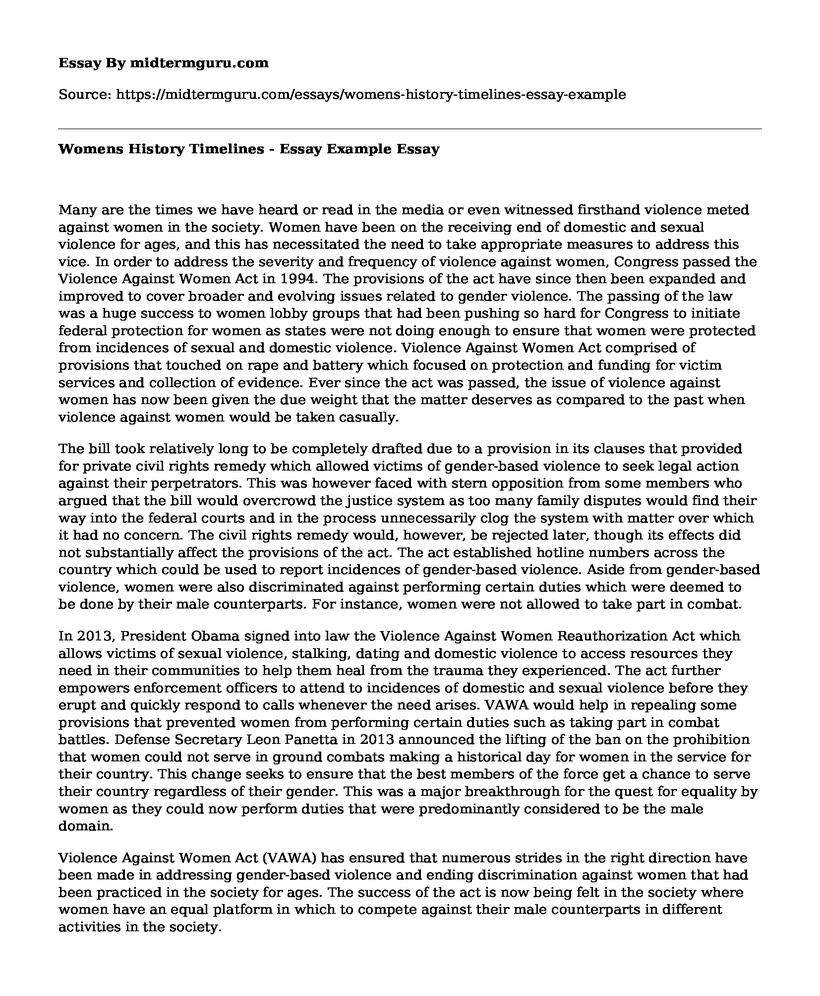Many are the times we have heard or read in the media or even witnessed firsthand violence meted against women in the society. Women have been on the receiving end of domestic and sexual violence for ages, and this has necessitated the need to take appropriate measures to address this vice. In order to address the severity and frequency of violence against women, Congress passed the Violence Against Women Act in 1994. The provisions of the act have since then been expanded and improved to cover broader and evolving issues related to gender violence. The passing of the law was a huge success to women lobby groups that had been pushing so hard for Congress to initiate federal protection for women as states were not doing enough to ensure that women were protected from incidences of sexual and domestic violence. Violence Against Women Act comprised of provisions that touched on rape and battery which focused on protection and funding for victim services and collection of evidence. Ever since the act was passed, the issue of violence against women has now been given the due weight that the matter deserves as compared to the past when violence against women would be taken casually.
The bill took relatively long to be completely drafted due to a provision in its clauses that provided for private civil rights remedy which allowed victims of gender-based violence to seek legal action against their perpetrators. This was however faced with stern opposition from some members who argued that the bill would overcrowd the justice system as too many family disputes would find their way into the federal courts and in the process unnecessarily clog the system with matter over which it had no concern. The civil rights remedy would, however, be rejected later, though its effects did not substantially affect the provisions of the act. The act established hotline numbers across the country which could be used to report incidences of gender-based violence. Aside from gender-based violence, women were also discriminated against performing certain duties which were deemed to be done by their male counterparts. For instance, women were not allowed to take part in combat.
In 2013, President Obama signed into law the Violence Against Women Reauthorization Act which allows victims of sexual violence, stalking, dating and domestic violence to access resources they need in their communities to help them heal from the trauma they experienced. The act further empowers enforcement officers to attend to incidences of domestic and sexual violence before they erupt and quickly respond to calls whenever the need arises. VAWA would help in repealing some provisions that prevented women from performing certain duties such as taking part in combat battles. Defense Secretary Leon Panetta in 2013 announced the lifting of the ban on the prohibition that women could not serve in ground combats making a historical day for women in the service for their country. This change seeks to ensure that the best members of the force get a chance to serve their country regardless of their gender. This was a major breakthrough for the quest for equality by women as they could now perform duties that were predominantly considered to be the male domain.
Violence Against Women Act (VAWA) has ensured that numerous strides in the right direction have been made in addressing gender-based violence and ending discrimination against women that had been practiced in the society for ages. The success of the act is now being felt in the society where women have an equal platform in which to compete against their male counterparts in different activities in the society.
References
History of VAWA. (2016). Legalmomentum.org. Retrieved 28 October 2016, from https://www.legalmomentum.org/history-vawa
Jarrett, V. (2013). No One Should Have to Live in Fear of Violence. whitehouse.gov. Retrieved 28 October 2016, from https://www.whitehouse.gov/blog/2013/03/07/no-one-should-have-live-fear-violence
Roulo, C. (2013). Defense Department Expands Womenas Combat Role. Archive.defense.gov. Retrieved 28 October 2016, from http://archive.defense.gov/news/newsarticle.aspx?id=119098
Cite this page
Womens History Timelines - Essay Example. (2021, May 24). Retrieved from https://midtermguru.com/essays/womens-history-timelines-essay-example
If you are the original author of this essay and no longer wish to have it published on the midtermguru.com website, please click below to request its removal:
- Essay on Corporal Punishment of Children
- Do Video Games Lead to Gun Violence? - Paper Example
- The LGBT Community Discrimination - Essay Sample
- Black Struggle for Social Justice: Overcoming Racism in 20th-Century America - Essay Sample
- Cycle of Violence & Maltreatment: Trauma & Abuse Impacting Adults - Essay Sample
- Essay Sample on Elderly Abuse Mandatory Reporting
- Exploring Theoretical and Best Practice Models in Research - Essay Sample







